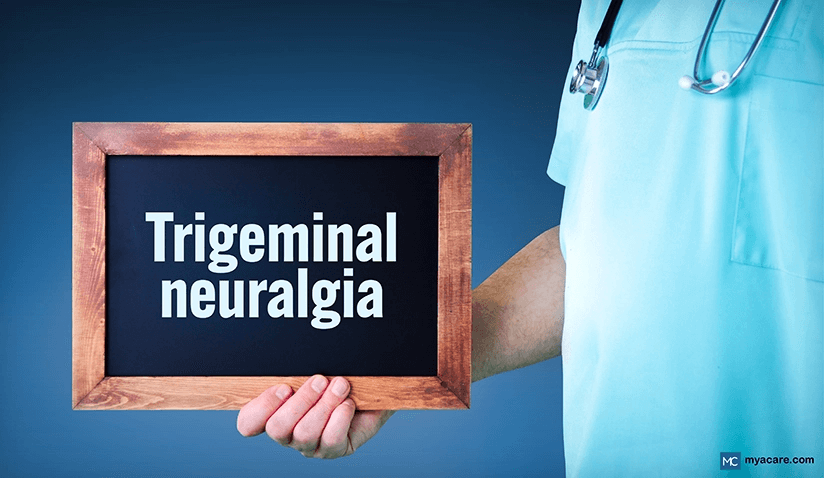Understanding Trigeminal Neuralgia: Causes and Treatments

Medically Reviewed by Dr. Rae Osborn, Ph.D. - August 14, 2024
Trigeminal neuralgia (TN) is a neurologic condition of chronic pain that impacts the trigeminal nerve in the face. The sudden and severe pain that characterizes the condition is often triggered by everyday activities such as eating, talking, or brushing teeth. The pain is debilitating for many with the condition.'
Trigeminal neuralgia affects approximately 4-13 people per 100,000 annually. It is more common in women and typically occurs in people over 50.
This article explores the causes, symptoms, and treatment options for trigeminal neuralgia, as well as the latest research and future outlook for this condition.
Trigeminal Neuralgia Overview
Neuralgia refers to any chronic nerve-related pain. Trigeminal neuralgia is a pain disorder that affects the trigeminal nerve. It is also known as 'tic douloureux' (painful tic) or Fothergill's disease.
The pain is sharp, shooting, or feels like electric shock, with the slightest touch or movement in the face able to trigger an attack.
Trigeminal Nerve Anatomy
The trigeminal nerve is classified as the fifth cranial nerve that innervates facial sensations, including those of the forehead, cheeks, and jaw.
The three trigeminal nerve branches allude to the symptoms and triggers of trigeminal neuralgia[1]:
- The ophthalmic branch (V1) governs sensation in the forehead, eye, and upper eyelid.
- The maxillary branch (V2) governs sensation in the upper lip, gum, nostrils, cheeks, and lower eyelids.
- The mandibular branch (V3) governs sensation in the lower lip, gum, jawline, and chewing muscles.
These three branches lead back to the pons in the brainstem, which coordinates basic involuntary and voluntary movements, such as blinking, breathing, and chewing.
Causes and Risk Factors
In trigeminal neuralgia, the trigeminal nerve is compressed or irritated, leading to the characteristic pain.[2]
According to experts, the cause of 80-90% of trigeminal neuralgia cases is the compression of blood vessels that run adjacent to the root of the nerve near the pons. In most of these instances, this compression originates from the superior cerebellar artery. Other blood vessels frequently implicated include the vertebral artery and the anterior inferior cerebellar artery.
Although less prevalent, trigeminal neuralgia may occur secondary to another medical condition that results in nerve compression, such as:
- Meningioma
- Acoustic neuroma
- Epidermoid cyst
- Arteriovenous malformation
- Saccular aneurysm
- Facial nerve injury
Approximately 2-4% of those with multiple sclerosis have trigeminal neuralgia. Multiple sclerosis is a disease in which the myelin sheath that protects the nerves progressively degrades. This degradation, known as demyelination, can happen to the trigeminal nerve and lead to trigeminal neuralgia pain.
Certain risk factors that may increase the likelihood of developing trigeminal neuralgia include:
- Previous facial trauma or surgery
- Family history of trigeminal neuralgia
- Certain medical conditions, such as diabetic neuropathy and hypertension
Types and Symptoms of Trigeminal Neuralgia
The main symptom of TN is a burst of severe facial pain with a sudden onset that lasts a few seconds to minutes and that occurs in repeated episodes several times a day.
There are two prime types: classic and atypical.
- Classic trigeminal neuralgia is the most common form.
This sudden, severe, and sharp facial pain ("electric-shock" type pain) is often triggered by everyday activities, such as eating, talking, or brushing teeth.
- Atypical trigeminal neuralgia is less common (present in 15% of cases).
Also known as secondary neuralgia or symptomatic neuralgia, this type presents with constant burning or aching pain.
In addition to facial pain, some people with trigeminal neuralgia may experience other symptoms, such as tearing and redness of eyes, or sensitivity to light. These symptoms are more common in atypical trigeminal neuralgia.
Other causes may include trigeminal neuralgia as a result of secondary conditions, such as postherpetic trigeminal neuralgia in shingles patients infected with varicella-zoster.
When there is no identifiable cause, medical professionals refer to the condition as idiopathic trigeminal neuralgia.
Trigeminal Neuralgia Triggers
Triggers of trigeminal neuralgia pain include a variety of everyday activities known to stimulate the nerve, such as[3]:
- Eating or drinking
- Talking or laughing
- Brushing teeth
- Touching the face
- Cold air or wind
- Shaving or applying makeup
- Smiling or facial expressions
Sometimes, the condition gets worse over time, with more frequent and prolonged attacks. In progressive TN, they may be constant. Medication may become less effective in these cases.
Diagnosis of Trigeminal Neuralgia
Diagnosing trigeminal neuralgia can be challenging, as no specific test exists for the condition.To rule out other possible reasons for the patient's symptoms, a doctor will examine the patient physically and review their medical history.
Imaging tests, such as an MRI or CT scan, may be ordered to look for abnormalities or trigeminal nerve compression.
How does Trigeminal Neuralgia differ from a TMJ disorder?
A temporomandibular joint (TMJ) disorder and trigeminal neuralgia are distinct conditions that can cause facial pain and headaches.[4]
TMJ disorders result from issues with the jaw joint, such as those caused by teeth grinding, uneven bite, or injury. Symptoms of TMJ disorders are usually less severe and sudden compared to trigeminal neuralgia. OTC pain medications like ibuprofen are often effective in relieving TMJ disorder symptoms.
Treatment Options for Trigeminal Neuralgia
Treatment will rely upon symptom severity and the patient’s overall health.
There are many options, and those with TN may need to try several before they find one that helps them to manage their condition.
Medications
The first line of treatment for trigeminal neuralgia is usually medications. These may include[5]:
These medications help to reduce the frequency and severity of pain episodes. However, they may also cause side effects like dizziness, drowsiness, or nausea.
Minimally Invasive Procedures
If medications are ineffective or cause intolerable side effects, your doctor may recommend minimally invasive procedures to relieve trigeminal neuralgia symptoms. These procedures include:
- Radiofrequency ablation[9], which uses heat to damage the part of the nerve causing the pain and thus, prevents pain signals from being transmitted
- Minimally invasive neurolytic techniques[10] such as ozone injection or low-level laser therapy
- Glycerol injection[11] injects a sterile solution into the nerve to damage it and prevent pain signals
- Balloon compression[12] places a small balloon near the nerve and inflates it to damage the nerve and prevent pain signals
- Nerve blocks inject a local anesthetic into the nerve to block pain signals temporarily
These treatments, which are usually done as outpatient procedures, can offer sustained alleviation from the symptoms of trigeminal neuralgia.
Lesioning Procedures
For more severe cases of trigeminal neuralgia, surgery may be recommended.
Lesioning procedures involve damaging or destroying the trigeminal nerve to prevent pain signals from being transmitted.
These procedures include:
- Surgery such as microvascular decompression, trigeminal nerve sectioning, or rhizotomy
- Stereotactic radiosurgery (gamma knife) uses focused radiation to damage the nerve and prevent pain signals
These procedures carry a higher risk of complications and may result in permanent numbness or weakness in the face.
Alternative Therapies
Some people with trigeminal neuralgia may find relief from alternative therapies. These therapies may help to reduce pain and improve overall well-being, yet they should not be used as a replacement for medical treatment.
Examples include:
- Acupuncture
- Chiropractic treatment of the upper spine
- Biofeedback
- Vitamin therapy
Can Trigeminal Neuralgia Be Prevented?
Unfortunately, there is no known way to prevent trigeminal neuralgia. However, managing underlying medical conditions and avoiding triggers may help to reduce the frequency and severity of pain episodes.
Prognosis and Living with Trigeminal Neuralgia
The prognosis for trigeminal neuralgia varies from person to person. Some people may experience long periods of remission, while others may have persistent symptoms.
Close cooperation with a doctor to find the best treatment plan for your needs is essential.
Some tips for living with trigeminal neuralgia include:
- Avoiding triggers, such as cold air or wind
- Eating soft foods to avoid triggering pain while chewing
- Practicing good oral hygiene to prevent dental problems
- Avoiding foods that may trigger pain, such as hot or cold foods
- Managing stress through specialized techniques, such as meditation or yoga
- Joining a support group to connect with others who understand your experience
Research and Future Outlook
Research into trigeminal neuralgia is ongoing, focusing on finding more effective treatments and potential cures.
Some promising areas of research include:
- Developing new medications that target specific pain pathways
- Investigating the role of genetics in the development of trigeminal neuralgia since around 2% of cases may be familial[13]
- Exploring the use of stem cells to repair damaged nerves
- Studying the potential benefits of neuromodulation techniques, such as deep brain stimulation
The section below discusses several emerging therapies and medications that show promise in relieving pain in TN patients.
Magnetic Brain Stimulation
One area of research in TN is exploring emerging therapies such as repetitive transcranial magnetic stimulation (rTMS).
rTMS applies magnetic fields to the patient that stimulate specific brain areas involved in pain perception. Preliminary studies show that rTMS may provide significant pain relief for some TN patients.[14]
Neuromodulation
Neuromodulation is a newer treatment option for trigeminal neuralgia involving electrical stimulation to disrupt pain signals. This signal disruption is achievable through spinal cord stimulation or peripheral nerve stimulation.
More research is required to confirm the efficacy of neuromodulation techniques.[15]
Novel Medications
Several new medications are undergoing investigation for their effectiveness in TN management:
- Vixotrigine is a sodium channel blocker and opioid painkiller alternative that targets the hyperexcitability of trigeminal nerve fibers. Phase II trials have shown promising results.
- Eslicarbazepine, an antiepileptic drug, has also shown potential in reducing TN pain and improving quality of life in some patients.[16]
- Misoprostol has also shown potential in reducing TN pain in those with multiple sclerosis by modulating inflammation and sensitization of nerve fibers. In a trial, it caused a 50% reduction in pain intensity and frequency of attacks.
Future Therapies
Several potential therapies hold promise for improved TN management in future. These include:
- Gene therapy: Recent research highlights several genes possibly involved in trigeminal neuralgia, which gene therapies may help to treat in the future.[17]
- Stem cell therapy: Stem cell research offers hope for regenerative approaches to repair damaged trigeminal nerve fibers and provide long-lasting relief. Animal studies suggest the efficacy of stem cell treatments, with some entering clinical trials for treating trigeminal neuralgia.
Conclusion
Trigeminal neuralgia is a chronic neurological disorder characterized by pain in the face and trigeminal nerve areas. While no known cure exists, several treatment options are available, including medications, minimally invasive procedures, and surgery. By working closely with a doctor and managing triggers, patients can find relief and improve their quality of life. With the aid of ongoing research and treatment advancements, there is hope for a better future for those living with trigeminal neuralgia.
To search for the best Neurology Doctors and Healthcare Providers worldwide, please use the Mya Care search engine.
To search for the best healthcare providers worldwide, please use the Mya Care search engine.
The Mya Care Editorial Team comprises medical doctors and qualified professionals with a background in healthcare, dedicated to delivering trustworthy, evidence-based health content.
Our team draws on authoritative sources, including systematic reviews published in top-tier medical journals, the latest academic and professional books by renowned experts, and official guidelines from authoritative global health organizations. This rigorous process ensures every article reflects current medical standards and is regularly updated to include the latest healthcare insights.

Dr. Rae Osborn has a Ph.D. in Biology from the University of Texas at Arlington. She was a tenured Associate Professor of Biology at Northwestern State University, where she taught many courses to Pre-nursing and Pre-medical students. She has written extensively on medical conditions and healthy lifestyle topics, including nutrition. She is from South Africa but lived and taught in the United States for 18 years.
Sources:
Featured Blogs



